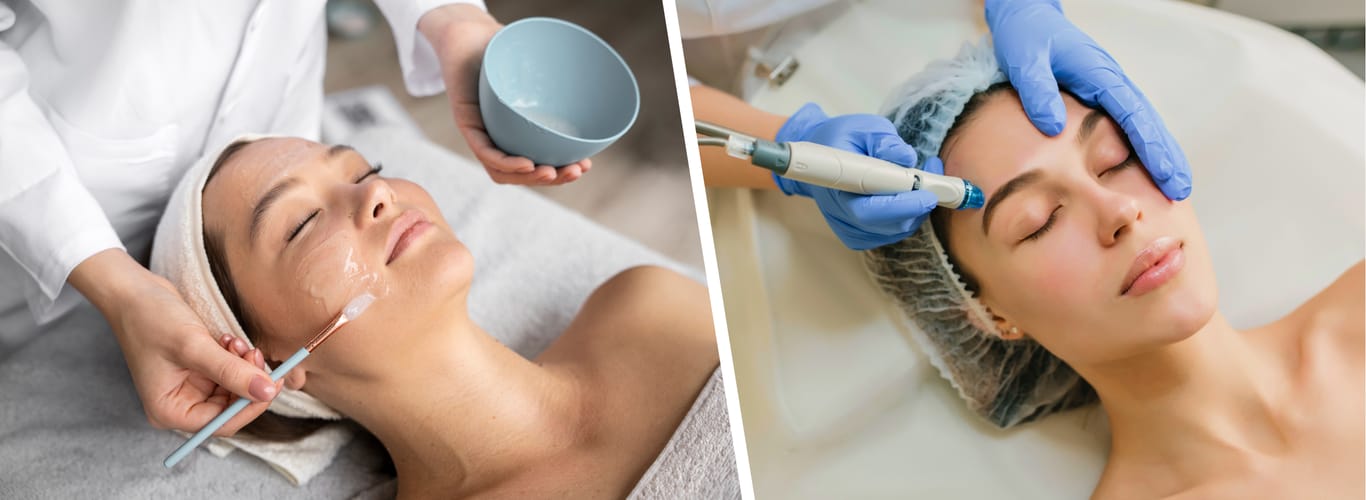Microneedling vs. chemical peel | Comparing, using together & combining
Navigating the world of skincare treatments can be overwhelming. In the debate of microneedling vs. chemical peel, which reigns supreme for various skin concerns? Dive into this guide to unearth the benefits, comparisons, and art of combining both procedures. Your journey to rejuvenated skin starts here.
What are microneedling and chemical peel?
Microneedling and chemical peels have emerged as two popular choices for those looking to enhance their skin's appearance and health. But what are they exactly?
Microneedling, often referred to as collagen induction therapy, is a minimally invasive procedure that involves using tiny, sterile needles to create thousands of micro-injuries on the skin’s surface. These controlled injuries stimulate the body’s natural wound-healing processes, promoting collagen and elastin production. As a result, the skin becomes firmer, smoother, and more youthful.
Imagine aerating your lawn, where small holes allow better nutrient absorption. Microneedling operates on a similar principle but for your skin, letting beneficial products penetrate deeper.
A chemical peel is a treatment in which a chemical solution is applied to the skin, causing it to “peel” off, revealing the newer, regenerated skin beneath. Chemical peels aim to improve the skin’s appearance by reducing fine lines, wrinkles, age spots, and sun damage. The intensity of the peel—ranging from light to deep—determines the level of skin exfoliation.
Think of it as an accelerated form of exfoliation. It's akin to peeling layers from an onion, with each layer unveiling fresher skin below.
Key takeaways:
- Depth and intensity: while microneedling works by promoting internal healing mechanisms, chemical peels function by removing the outermost layers of the skin to reveal fresher layers beneath.
- Targeted concerns: both treatments can address a variety of skin issues, from wrinkles to scars. However, their efficacy and suitability may vary based on the specific concern and individual skin types.
- Invasive vs. topical: microneedling is considered minimally invasive due to needle penetration, while chemical peels are topical treatments that work on the skin’s surface.
Understanding these fundamental distinctions sets the stage for a deeper exploration of the pros, cons, and best scenarios for each treatment in subsequent chapters.
Pros and cons of each procedure
When deliberating between microneedling vs chemical peel, or even considering combining them, it’s crucial to understand their respective advantages and drawbacks. Let's break them down:
Microneedling
| Pros | Column B |
|---|---|
1. Natural collagen boost: uses the body’s own healing processes to increase collagen production. 2. Minimally invasive: penetrates the skin without the use of chemicals. 3. Versatility: effective for a variety of concerns like scars, large pores, and uneven skin texture. | 1. Downtime: redness or minor swelling can occur post-treatment, typically lasting a few days. 2. Potential side effects: risk of infection or scarring if aftercare is neglected. |
Chemical peel
| Pros | Cons |
|---|---|
1. Rapid turnover: speeds up cell turnover, quickly revealing younger, more radiant skin. 2. Customizable: peels come in various strengths, allowing tailored treatments. 3. Effective exfoliation: efficiently addresses surface issues like fine lines, sunspots, and uneven tone. | 1. Skin peeling: post-treatment, the skin will physically peel, sometimes for up to a week. 2. Sensitivity: skin can become more sensitive to the sun post-procedure, necessitating diligent sunscreen use. |
In the refined world of skincare, the dialogue between chemical peels and microneedling, each procedure has its strengths and limitations.
Your choice should reflect your skin concerns, tolerance for downtime, and desired results. And before you step into this transformative dance, seek the wisdom of a skincare virtuoso to illuminate your way with precision and care.
Comparison of microneedling vs. chemical peels for different skin conditions
Skincare, with its plethora of treatments, often puts us at a crossroads. Especially in the chemical peel and microneedling debate, the choice seems ever-evolving. Let's dissect their efficacy for specific skin conditions:
For acne scars
- Microneedling: a star in this arena, microneedling dives deep into the dermis, promoting collagen that fills indented scars from within. Results often show marked improvement in the texture and appearance of both atrophic and rolling acne scars.
- Chemical peel: while peels can fade post-acne marks and superficial scars, they may not be as effective for deeper scars. A series of deeper peels, however, can yield noticeable results.
For hyperpigmentation
- Microneedling: by stimulating a rapid cell turnover, microneedling can lighten dark spots and even out skin tone over time.
- Chemical peel: highly effective, especially for superficial pigmentation. Peels expedite the exfoliation process, pushing pigmented cells to the surface and then shedding them.
For pores
- Microneedling: shrinks pores by boosting collagen, which supports the pore walls and prevents them from becoming enlarged.
- Chemical peel: temporary reduction in the appearance of pores is possible by clearing them out and tightening the surrounding skin.
For melasma
- Microneedling: it’s a safer bet for those with melasma, especially if there's a risk of post-inflammatory hyperpigmentation. Microneedling can gradually fade the patches without excessive heat or trauma.
- Chemical peel: mild peels may help, but stronger peels can exacerbate melasma or cause darkening, especially if not administered properly.
For wrinkles
- Microneedling: by promoting collagen, microneedling addresses the root cause of wrinkles, making the skin plumper and reducing fine lines.
- Chemical peel: effective especially for superficial wrinkles. Deeper peels can reduce the appearance of more pronounced wrinkles, but come with more downtime.
While both treatments hold their ground, the choice between chemical peel and microneedling often hinges on the specific skin concern and the depth of the condition. Microneedling excels in collagen promotion, addressing issues from the inside out, whereas chemical peels rejuvenate from the surface.
A well-informed decision, rooted in consultation with a skincare expert, remains paramount.
How to combine microneedling and chemical peel
In the sophisticated landscape of dermatology, optimizing results often leads professionals to consider the strategic integration of treatments. The confluence of microneedling and chemical peel together has emerged as a focal point of interest.
When artfully paired, these procedures can potentially enhance the efficacy of one another's efficacy. But the question of sequence and safety is paramount. Let’s delve into the intricacies.
Chemical peel before or after microneedling
Determining the correct order is akin to setting the stage for a successful performance.
Experts often recommend administering a chemical peel prior to microneedling. By clearing and refining the skin's top layer, a chemical peel enhances the subsequent effectiveness of microneedling, allowing for more uniform and deeper penetration.
Picture this as clearing the forest floor before planting new seeds. The chemical peel, by exfoliating the skin, ensures the subsequent microneedling reaps the best results.
Using together
You wouldn’t do them at the same time or during the same appointment.
Spacing: a crucial aspect to consider is the interval between sessions. Allowing the skin a recuperation window of 4–6 weeks is often recommended to maintain skin health.
Think of this akin to resting between intensive workouts. Your skin, much like muscles, requires recovery time to ensure maximum gains.
In conclusion, the combination of microneedling and chemical peel offers a comprehensive approach to skin rejuvenation. While experts typically recommend starting with a chemical peel, the timing between the two treatments is crucial for optimal results and skin health. A gap of 4–6 weeks is generally advised to ensure safety and effectiveness. It's essential to seek advice from dermatological professionals when considering these procedures, as their guidance ensures the best possible outcomes. With the right approach, combining these treatments can lead to remarkable results.
Choosing the right treatment for you
Navigating the world of skincare treatments can be overwhelming. With numerous options available, it's essential to identify the treatment that aligns with your unique skin concerns, goals, and comfort level.
- Firstly, pinpoint what you wish to address. Is it deep-seated acne scars? Or perhaps surface-level hyperpigmentation?
Example: Sarah, who had battled cystic acne in her teens, found herself contending with pitted scars in her late twenties. For her, microneedling was the most viable option, offering depth and collagen induction to plump the scars from within.
- Consider your downtime. Each treatment comes with its recovery phase. Are you comfortable with some redness and peeling for a few days, or do you need to look presentation-ready immediately?
- Assessing tolerance levels. Your pain threshold plays a role. While neither procedure is particularly painful due to the use of numbing agents, there can be some discomfort.
- Consult a professional. Always discuss your case with a dermatologist or licensed esthetician. They'll consider your skin type, history, and goals to recommend the best procedure or combination for you.
- Financial Commitment. Consider the cost and the number of sessions required. Some treatments might be more budget-friendly upfront but require more frequent sessions.
Selecting the ideal skincare hinges on understanding one's distinct skin challenges, personal preferences, and available resources. While the allure of quick results can be tempting, it's paramount to choose treatments tailored to your individual needs. Always prioritize professional guidance; their expertise is invaluable in navigating the myriad of options.
At the end of the day, skincare is a journey; ensuring that each step is thoughtfully considered will lead to fulfilling and lasting results.
 Elevate your glow with proven beauty secrets
Elevate your glow with proven beauty secrets
Dive in now for the latest beauty hacks, expert-approved tips, and transformative routines!
Oh no! We couldn’t subscribe you ☹️
Done! You've subscribed 💛
Unsubscribe anytime. Your data is stored for business-to-business communication purposes. See our Privacy policy.
Frequently asked questions
What is better: chemical peel or microneedling?
Whether chemical peels or microneedling is better depends on your skin type, concerns, and goals. Chemical peels are great for surface issues, while microneedling targets deeper layers.
Is microneedling or chemical peel better for pores?
For pore reduction, microneedling is often more effective as it stimulates collagen, helping pores appear smaller.
Can you do microneedling and chemical peel together?
Combining microneedling and chemical peels is possible but should be done carefully under professional guidance to avoid over-treating the skin.
Is microneedling or chemical peel better for acne?
For acne, microneedling can be more effective for deeper scars, while chemical peels are good for superficial acne marks. Always consult a dermatologist.
Last updated on Aug 28, 2023
“What Changed” in this article? Everything. It's packed with the latest findings, the ripest data, and a fresh analysis you won't find anywhere else.
A subject-matter expert wrote the content, and reliable, official sources support it. Recent research has been incorporated to maintain relevancy and accuracy.
Key sources and research references: aocd and naomedical
Please share this post
Unlock the secrets to beauty business success!
Join our community for insider tips on product management, marketing, sales and client attraction. Elevate your business with expert insights delivered straight to your inbox.
Oh no! We couldn’t subscribe you ☹️
Done! You've subscribed 💛
Trusted by the best in the beauty industry.
Transform your beauty business with Suplery!
Already enjoying our expert tips? Take the next step and join Suplery to revolutionize your business operations.
Huge range of professional products
One-click checkout after first order
Automated predictive orders
Seamless inventory management
From words to action
Start working with Suplery and explore all the tools and services you need to expand your business
Get started with Suplery24/7 Support
Secure payments
Designed by industry’s experts


